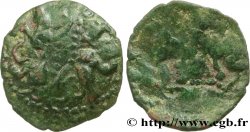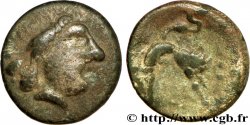v41_1560 - HOARD OF BRIDIERS (CREUSE) Drachme au lion et à l’échassier
MONNAIES 41 (2009)
Starting price : 280.00 €
Estimate : 500.00 €
Realised price : 382.00 €
Number of bids : 3
Maximum bid : 382.00 €
Starting price : 280.00 €
Estimate : 500.00 €
Realised price : 382.00 €
Number of bids : 3
Maximum bid : 382.00 €
Type : Drachme au lion et à l’échassier
Date: IIIe - IIe siècles avant J.-C.
Metal : silver
Diameter : 17 mm
Orientation dies : 8 h.
Weight : 3,30 g.
Rarity : R3
Coments on the condition:
Monnaie sur un flan régulier, relativement large et épais. Droit très légèrement décentré mais aux reliefs bien nets. Revers de frappe un peu molle, mais centrée, avec le type complet. Épaisse patine gris foncé
Catalogue references :
Obverse
Obverse legend : ANÉPIGRAPHE.
Obverse description : Tête d’Apollon laurée à droite.
Reverse
Reverse legend : ANÉPIGRAPHE.
Reverse description : Animal hybride dérivé du lion des drachmes de Marseille ; un échassier à droite, posé sur son dos, avec une étoile au-dessus de la queue du lion.
Commentary
Ce type précis est très rare ; un exemplaire inédit a été publié par A. Deroc dans le C.N. pages 252-255 en 1979. Malgré une mauvaise qualité de photographie à l’époque, l’exemplaire proposé ici semble être issu du même coin de droit.
Ce type a curieusement été oublié dans le Tome III du Nouvel Atlas, qui ne reprend qu’une autre variété inédite (DT. 3307B) proche de cette monnaie mais avec un cercle inscrit dans un quadrilatère derrière l’échassier. Le Tome IV reprend une monnaie oubliée de cette série, pourtant illustrée dans le LA TOUR (BN. 2253), avec une tête à gauche et un annelet pointé au-dessus du lion.
Notre type de drachme manque donc toujours au Nouvel Atlas.
Après l’exemplaire publié par A. Deroc et le magnifique exemplaire n° 222 de la vente BURGAN du 26 juin 2004, cette monnaie semble être la troisième connue pour ce type à l’échassier et à l’étoile.
This specific type is very rare; an unpublished example was published by A. Deroc in the CN pages 252-255 in 1979. Despite poor photographic quality at the time, the example offered here seems to come from the same obverse die. This type was curiously forgotten in Volume III of the New Atlas, which only includes another unpublished variety (DT. 3307B) close to this coin but with a circle inscribed in a quadrilateral behind the wader. Volume IV includes a forgotten coin from this series, yet illustrated in the LA TOUR (BN. 2253), with a head to the left and a pointed annulet above the lion. Our type of drachma is therefore still missing from the New Atlas. After the example published by A. Deroc and the magnificent example no. 222 of the BURGAN sale of June 26, 2004, this coin seems to be the third known for this type with the wader and the star.
Ce type a curieusement été oublié dans le Tome III du Nouvel Atlas, qui ne reprend qu’une autre variété inédite (DT. 3307B) proche de cette monnaie mais avec un cercle inscrit dans un quadrilatère derrière l’échassier. Le Tome IV reprend une monnaie oubliée de cette série, pourtant illustrée dans le LA TOUR (BN. 2253), avec une tête à gauche et un annelet pointé au-dessus du lion.
Notre type de drachme manque donc toujours au Nouvel Atlas.
Après l’exemplaire publié par A. Deroc et le magnifique exemplaire n° 222 de la vente BURGAN du 26 juin 2004, cette monnaie semble être la troisième connue pour ce type à l’échassier et à l’étoile.
This specific type is very rare; an unpublished example was published by A. Deroc in the CN pages 252-255 in 1979. Despite poor photographic quality at the time, the example offered here seems to come from the same obverse die. This type was curiously forgotten in Volume III of the New Atlas, which only includes another unpublished variety (DT. 3307B) close to this coin but with a circle inscribed in a quadrilateral behind the wader. Volume IV includes a forgotten coin from this series, yet illustrated in the LA TOUR (BN. 2253), with a head to the left and a pointed annulet above the lion. Our type of drachma is therefore still missing from the New Atlas. After the example published by A. Deroc and the magnificent example no. 222 of the BURGAN sale of June 26, 2004, this coin seems to be the third known for this type with the wader and the star.








 Report a mistake
Report a mistake Print the page
Print the page Share my selection
Share my selection Ask a question
Ask a question Consign / sell
Consign / sell










